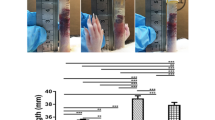Abstract
Treatment options for Peyronie’s disease (PD) remain limited. Topical H100 gel, (Hybrid Medical, Edina, USA), which contains nicardipine, super oxide dismutase and emu oil showed safety and efficacy in a previous small double-blind placebo-controlled pilot study. The present study evaluates if topically applied H100 gel applied to the penile shaft infiltrates the tunica albuginea. Nicardipine is a key active ingredient in H100 and serves as a surrogate marker. Three men already scheduled to undergo a planned surgical procedure for PD applied commercially available H100 gel twice daily to the penile shaft for up to 30 days prior to the procedure. Tunica albuginea samples were obtained at surgery. Nicardipine evaluation was performed using isotope dilution technique via liquid-chromatograph-mass spectrometry (LCMS). All three patients tolerated H100 gel application without side effects. All three tunica albuginea specimens showed detectable nicardipine in the tunical tissue. Transdermal application of commercially available H100 gel is able to penetrate the tunica albuginea tissue and is detectable in men with acute and chronic PD. This finding may support the encouraging results found in the prior H100 pilot study.
This is a preview of subscription content, access via your institution
Access options
Subscribe to this journal
Receive 8 print issues and online access
$259.00 per year
only $32.38 per issue
Buy this article
- Purchase on Springer Link
- Instant access to full article PDF
Prices may be subject to local taxes which are calculated during checkout
Similar content being viewed by others
References
Dibenedetti D, Nguyen D, Zografos L, Ziemiecki R, Zhou X. A population-based study of Peyronie’s disease: prevalence and treatment patterns in the United States. Adv Urol. 2011;2011:282503.
Barrett-Harlow B, Wang R. Oral therapy for Peyronie’s disease, does it work? Transl Androl Urol. 2016;5:296–302.
Ziegelmann M, Savage J, Toussi A, Alom M, Yang D, Kohler T, et al. Outcomes of a novel penile traction device in men with Peyronie’s disease: a randomized, single-blind, controlled trial. J Urol. 2019;202:599–610.
Levine L, Newell M, Taylor F. Penile traction therapy for treatment of Peyronie’s disease: a single-center pilot study. J Sex Med. 2008;5:1468–73.
Martin D, Badwan K, Parker M, Mulhall J. Transdermal application of verapamil gel to the penile shaft fails to infiltrate the tunica albuginea. J Urol. 2002;168:2483–5.
Levine L, Goldman K, Greenfield J. Experience with intraplaque injection of verapamil for Peyronie’s disease. J Urol. 2002;168:621–6.
Soh J, Kawauchi A, Kanemitsu N, Naya Y, Ochial A, Naltoh Y, et al. Nicardipine vs saline injection as treatment for Peyronie’s disease: a prospective, randomized, single-blind study. J Sex Med. 2010;7:3743–9.
Gelbard M, Goldstein I, Hellstrom W, McMahon C, Smith T, Tursi J, et al. Clinical efficacy, safety and tolerability of collagenase clostridium histolyticum for the treatment of Peyronie’s disease in 2 large double-blind, randomized, placebo-controlled phase 3 studies. J Urol. 2013;190:199–207.
Twidwell J, Levine L. Topical treatment for acute phase Peyronie’s disease utilizing a new gel, H-100; a randomized, prospective, placebo-controlled pilot study. Int J Impot Res. 2016;28:41–45.
Fitch W, Easterling W, Talbert R, Bordovsky M, Mosier M. Topical verapamil HCL, topical trifluoperazine, and topical magnesium sulfate for the treatment of Peyronie’s disease- a placebo—controlled pilot study. J Sex Med. 2007;4:477–84.
Zemtsov A, Gaddis M, Montalvo-Lugo V. Moisturizing and cosmetic properties of emu oil: a double-blind study. Aust J Dermatol. 1996;37:159–61.
Qiu X, Wang J, Fang X, Gong Z, Li Z, Yi Z. Anti-inflammatory activity and healing-promoting effects of topical application of emu oil on wound in scaled rats. Di Yi Jun Yi Da Xue Xue Bao. 2005;25:407–10.
Kouoh F, Gressier B, Dine T, Luyckx M, Brunet C, Ballester L, et al. Antioxidant effects and anti-elastase activity of the calcium antagonist nicardipine on activated human and rabbit neutrophils—a potential antiatherosclerotic property of calcium antagonists? Cardiovasc Drugs Ther. 2002;16:515–20.
Kinnula V, Crapo J. Superoxide dismutases in the lung and human lung diseases. Am J Respir Crit Care Med. 2003;167:1600–19.
Yamane N, Takami T, Tozuka Z, Sugiyama Y, Yamazaki A, Kumagai Y. Microdose clinical trial: quantitative determination of nicardipine and prediction of metabolites in human plasma. Drug Metab Pharmacokinet. 2009;24:389–403.
Author information
Authors and Affiliations
Contributions
JT: study design, manuscript creation; JM: patient enrollment; DT: patient enrollment; LL: study design, manuscript review.
Corresponding author
Ethics declarations
Competing interests
JT: Chairman Hybrid Medical, JM: compensated for study patient enrollment by Hybrid Medical, DT: compensated for study patient enrollment by Hybrid Medical, LL: compensated Medical Advisor, Hybrid Medical.
Additional information
Publisher’s note Springer Nature remains neutral with regard to jurisdictional claims in published maps and institutional affiliations.
Rights and permissions
Springer Nature or its licensor (e.g. a society or other partner) holds exclusive rights to this article under a publishing agreement with the author(s) or other rightsholder(s); author self-archiving of the accepted manuscript version of this article is solely governed by the terms of such publishing agreement and applicable law.
About this article
Cite this article
Twidwell, J., Mahon, J., Tortorelis, D. et al. Transdermal application of H100 gel to the penile shaft in patients with Peyronie’s disease infiltrates the tunica albuginea. Int J Impot Res 36, 107–109 (2024). https://doi.org/10.1038/s41443-023-00819-w
Received:
Revised:
Accepted:
Published:
Issue Date:
DOI: https://doi.org/10.1038/s41443-023-00819-w
This article is cited by
-
Unveiling treatment horizons and contemporary perspectives in Peyronie’s disease – take home messages from Laurance A. Levine special issue
International Journal of Impotence Research (2024)



